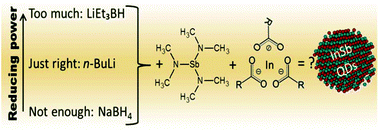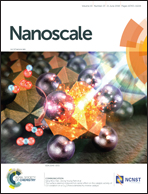Selective antimony reduction initiating the nucleation and growth of InSb quantum dots†
Abstract
Indium antimonide (InSb) quantum dots (QDs) have unique and interesting photophysical properties, but widespread experimentation with InSb QDs is lacking due to the difficulty in synthesizing this material. The key experimental challenge in fabricating InSb QDs is preparing a suitable Sb-precursor in the correct oxidation state that reacts with the In-precursor in a controllable manner. Here, we review and discuss the synthetic strategies for making colloidal InSb QDs and present a new reaction scheme yielding small (∼1 nm diameter) InSb QDs. This was accomplished by employing Sb(NMe2)3 as the antimony precursor and by screening different reducing agents that can selectively reduce it to stibine in situ. The released SbH3, subsequently, reacts with In carboxylate to form small InSb clusters. The absorption features are moderately tunable (from 400 nm to 660 nm) by the amount and rate of reductant addition as well as the temperature of injection and subsequent annealing. Optical properties were probed with transient absorption spectroscopy and show complex time and spectral dependencies.



 Please wait while we load your content...
Please wait while we load your content...